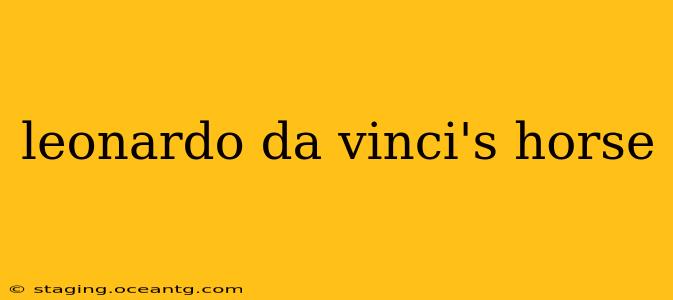Leonardo da Vinci, a name synonymous with genius, left behind a legacy that continues to fascinate and inspire centuries later. Beyond the Mona Lisa and The Last Supper, lies a lesser-known, yet equally compelling aspect of his work: his ambitious, and ultimately unfinished, project of a colossal equestrian statue. This article delves into the story of da Vinci's horse, exploring its conception, challenges, and enduring impact on art and engineering.
What was Leonardo da Vinci's horse sculpture?
Da Vinci's planned equestrian statue was intended to be a monumental bronze sculpture of Francesco Sforza, the first Duke of Milan, on horseback. It was conceived on an unprecedented scale, dwarfing any existing equestrian statue of its time. The sheer ambition of the project, both artistically and technically, is what makes it so remarkable. Da Vinci envisioned a powerful and lifelike representation of the Duke, capturing not only his physical likeness but also his strength and authority. The design itself was innovative, showcasing da Vinci's mastery of anatomy and his understanding of movement and weight distribution.
Why was Leonardo da Vinci's horse never finished?
The colossal size of the statue presented monumental challenges. The sheer amount of bronze required was immense, and the technology of the time was simply not advanced enough to cast such a large piece in one go. Da Vinci spent years experimenting with different techniques, creating detailed wax models and undertaking meticulous anatomical studies of horses. Unfortunately, despite his dedication and innovative approaches, he was ultimately unable to overcome the technical hurdles involved in casting the statue. Furthermore, the shifting political landscape of Milan and the subsequent French invasion interrupted his work, leading to the project's eventual abandonment.
What happened to the clay model of Leonardo da Vinci's horse?
The full-scale clay model of the horse, which da Vinci painstakingly created, was unfortunately destroyed. It was not cast in bronze during his lifetime, and over time, the clay model deteriorated, ultimately lost to history. However, its existence is well documented through da Vinci's own sketches and notes, along with accounts from contemporary sources. The loss of the model is a profound loss for art history, representing the disappearance of a significant piece of the artist's creative process.
How big was Leonardo da Vinci's horse?
Da Vinci's planned equestrian statue was envisioned to be incredibly large, significantly larger than any existing equestrian sculpture of its time. While the exact dimensions are debated by scholars, estimates suggest the horse itself would have been approximately 24 feet tall, placing the entire statue at a truly awe-inspiring height. This scale highlights the audacity of da Vinci's vision and the technical challenges he faced.
What materials was Leonardo da Vinci's horse intended to be made of?
The statue was planned to be made of bronze, a material chosen for its durability, strength, and the possibility of creating detailed, lifelike forms. The sheer volume of bronze needed, however, was a major contributing factor to the project's failure, given the limitations of bronze casting technology during the Renaissance. Da Vinci's detailed drawings and notes showcase his thorough consideration of the material and its properties.
What is the significance of Leonardo da Vinci's horse?
Despite its unfinished status, Leonardo da Vinci's horse holds immense significance in the history of art and engineering. It stands as a testament to da Vinci's boundless ambition, his innovative spirit, and his profound understanding of anatomy and mechanics. The project showcases his pioneering approach to sculpture, pushing the boundaries of artistic and technological capabilities in the Renaissance. Even though the bronze statue was never completed, its legacy continues to inspire artists and engineers alike. The project’s failure also served as a valuable learning experience, contributing to advancements in bronze casting techniques in later centuries. The enduring fascination with da Vinci's horse underscores the power of an unfinished masterpiece to capture the imagination and inspire awe. The story of its conception and its ultimate incompletion remains a powerful reminder of the challenges and triumphs inherent in the creative process.
